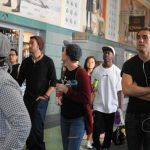Seeing the Past in the Present: A History Lesson Through Walk SF
Benjamin Rosete-Estrada
It was my second week working with Generation Citizen in a classroom. On the projector, there was an image of a map of San Francisco, displaying the districts and neighborhoods shaded in different colors to represent varying levels of unemployment. In front of me, the students, all 9th and 10th graders, took turns asking questions and pointing out things they noticed on the map.
In between questions and explanations however, my thoughts wandered back to when I’d been along the waterfront of the city as part of a historical walking tour several weeks before. The history walk was a requirement for the Ethics and Service Learning class I was a part of during the first week of the Fall 2015 semester course work. At first, I’ll admit, I had a hard time figuring out why I needed to know more about local history in a class centered on Aristotle and John Stuart Mills.
For three hours on that Saturday afternoon, I walked between buildings and stretches of shade, while listening to accounts of important events in San Francisco history organized by Shaping San Francisco. Along the different stops on that Saturday walk, we’d learned about the city’s long involvement with labor, from the “Eight Hour Work Day” movement to the general strikes of the 1930’s. Then there were the insights we’d gained into the changing cultural landscape of the city — how different immigrant groups left their legacy in San Francisco, how in spite of discrimination and political limitations, diverse communities survived.
- San Francisco History Walking Tour 2015
Some weeks after the walk, the service learning component of the class started and I was selected to work with Generation Citizen, an organization devoted to encouraging local action and teaching participation in democracy through the classroom.
Fast forward two weeks to the third class I was teaching when we discussed unemployment in the city. I started to draw connections between the history I had learned on the walk, and the work I was doing in the classroom. Even though I hadn’t realized it in the moment, learning what I did on the history walk gave me perspective I hadn’t had before; helping me see how events in the present — issues that the students in my classroom wanted to confront — had come about over time.
Many of the problems had changed, but beneath it all, different structures allowing for exclusion, discrimination and injustice were still in place.
Having had to the opportunity to go on the walk connected me in a personal way to the story of the City. It encouraged me to be more aware of current events in San Francisco, and take a closer look at the City’s past. At the same time, it allowed me to see the importance of local political action, and the need for me to become more engaged in civics.
It’s clearer for me to see now that this history serves as a backdrop for the narrative of San Francisco today. A narrative that I, the students I work with, and so many that live and work in the City, are a part of.







